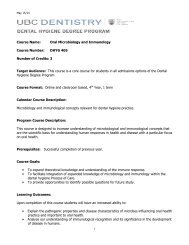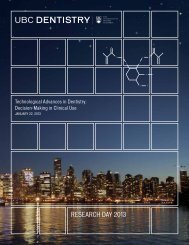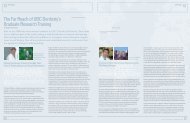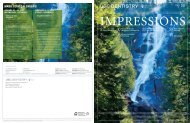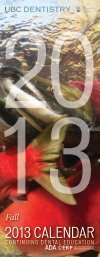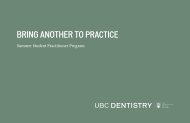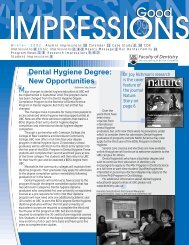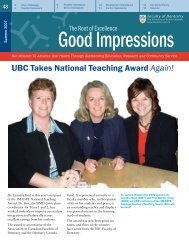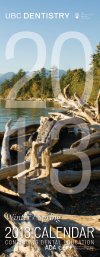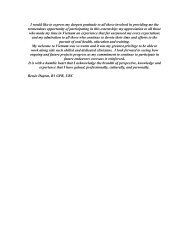Download a PDF of the fall 2012 edition - UBC Dentistry - University ...
Download a PDF of the fall 2012 edition - UBC Dentistry - University ...
Download a PDF of the fall 2012 edition - UBC Dentistry - University ...
- No tags were found...
Create successful ePaper yourself
Turn your PDF publications into a flip-book with our unique Google optimized e-Paper software.
12 FALL FALL 12“The opportunity to dive into clinical dentistry earlier than previous years isa welcomed change that benefits us due to <strong>the</strong> time it takes to develop properpsychomotor and clinical skills.” – Jordan Sanders, second-year DMD studentBiomedical Sciences—AssessingWhat Dentists Need to KnowBest ga<strong>the</strong>red toge<strong>the</strong>r feedback that had beencollected over <strong>the</strong> years from both studentsand instructors. The common concern fromstudents was that <strong>the</strong>y didn’t understand <strong>the</strong>need for all <strong>the</strong> medical information andwondered why it took so long for <strong>the</strong>m to learntechnical dentistry skills. From faculty andtutors <strong>the</strong> chief concern was not having enoughtime for what <strong>the</strong>y wanted to accomplish.Possibly <strong>the</strong> strongest catalyst for re-examining<strong>the</strong> breadth and depth <strong>of</strong> medical content camefrom <strong>the</strong> Faculty’s last accreditation review in2010, which suggested that <strong>the</strong> medical coursecontent that is not relevant to dentistry bereduced. Since students wanted to do dentistry,to learn <strong>the</strong> tools <strong>of</strong> <strong>the</strong> trade, while faculty andtutors are challenged with <strong>the</strong> lack <strong>of</strong> time toteach it, doing an evaluation <strong>of</strong> <strong>the</strong> medicalcourses as suggested by <strong>the</strong> accreditation reviewwas an obvious next step.Best and a team <strong>of</strong> faculty members received a<strong>UBC</strong> Teaching and Learning Enhancement Fund(TLEF) grant to conduct a one-year study toidentify <strong>the</strong> foundational biomedical scienceslearning objectives required for new graduates <strong>of</strong><strong>the</strong> <strong>UBC</strong> <strong>Dentistry</strong> program. A panel <strong>of</strong> fourthyear<strong>UBC</strong> dental students and faculty (dentalspecialists, general dentists, basic scientists) wassurveyed, using <strong>the</strong> Delphi method (Rand Project1959) for decision-making. The aim was to reacha 75 percent consensus among panelistsregarding each <strong>of</strong> <strong>the</strong> 13 year one and two medicalcourses reviewed.From <strong>the</strong> 81 learning objectives in <strong>the</strong> medicalreproduction course, <strong>the</strong>re was a 95 percentconsensus that 76 out <strong>of</strong> 81 learning objectiveswere not relevant to <strong>the</strong> practice <strong>of</strong> dentistry,while four learning objectives were “need toknow,” leaving one objective where consensuscould not be reached. Best says: “We readilyidentified that <strong>the</strong> medical reproductioncourse stood out to be fur<strong>the</strong>r scrutinized anddetermined that 106 hours <strong>of</strong> medicalreproduction content could be reduced to 17relevant to <strong>the</strong> practice <strong>of</strong> dentistry.”Removing students from this 106-hourmedical course and covering what dentistsneed to know <strong>of</strong> reproduction in 17 hoursopened up 89 hours in <strong>the</strong> second-yearcurriculum timetable. Best’s next task was tospearhead a revision <strong>of</strong> <strong>the</strong> entire second year.Medical Science and ClinicalSkills: A Balancing ActAt <strong>UBC</strong>, significant efforts have been made toimprove <strong>the</strong> correlation <strong>of</strong> biomedical sciences toclinical dental practice. The Faculty <strong>of</strong> <strong>Dentistry</strong>provides dentistry-related components used inbiomedical science courses, such as problembasedlearning scenarios that include dentaltriggers. The introduction <strong>of</strong> <strong>the</strong> Dental AppliedLearning Experiences (case-based learning)in <strong>the</strong> longitudinal dentistry course fur<strong>the</strong>rstreng<strong>the</strong>ns connections to dentistry.Additionally, <strong>Dentistry</strong> faculty members teach inMedicine’s head and neck anatomy laboratory,and <strong>the</strong> medical anatomist is present in <strong>the</strong>dental clinic; both encourage students to link <strong>the</strong>biomedical science to <strong>the</strong> practice <strong>of</strong> dentistry.Clinical skills training for dental studentsactually starts in year one with <strong>the</strong>Introduction to Clinical <strong>Dentistry</strong> (DENT 410)course, including supervised simulated patientexperiences among students and volunteers.(Supervised patient treatment with actualpatients starts in <strong>the</strong> second year.) It wasn’t thatstudents were learning only medicine-relatedinformation and not receiving clinical dentistrytraining in <strong>the</strong> first two years, but ra<strong>the</strong>r <strong>the</strong>issue was one <strong>of</strong> balance and distribution.Best explains: “At <strong>UBC</strong>, dental students learn<strong>the</strong> medical management <strong>of</strong> disease before <strong>the</strong>surgical management. If students receivedpsychomotor skills/operative dentistrytraining, a major module in year two, too early(such as in <strong>the</strong> first year), <strong>the</strong>re is a risk thatstudents will focus on <strong>the</strong> hand drill to <strong>the</strong>detriment <strong>of</strong> <strong>the</strong> medical management <strong>of</strong>disease. But <strong>the</strong> reverse can also happen:delaying it too long can be frustrating for <strong>the</strong>dental students, and concentrating it too muchmay be stressful and doesn’t allow enoughrepetitious practise.”Six years ago, psychomotor skills/operativedentistry training was taught at <strong>the</strong> end <strong>of</strong> yeartwo in an intense month <strong>of</strong>ten referred to asBoot Camp. Students were introduced to <strong>the</strong>handpiece, started to learn how to position<strong>the</strong>mselves ergonomically, and in just fourweeks <strong>the</strong>y had to accomplish a number <strong>of</strong>skill sets so that <strong>the</strong>y could move on into thirdyear. “That was an intensive time,” Bestremembers. “They needed more time topractise, to enjoy developing <strong>the</strong> skill sets andto become more confident.”In 2007, <strong>the</strong> Faculty was able to move <strong>the</strong>Psychomotor Skills/Operative (DENT 420PSO) module forward for a January start. With<strong>the</strong> time freed up in <strong>2012</strong> by greatly reducing<strong>the</strong> reproduction content and now delivering<strong>the</strong> 17 hours over several modules in <strong>the</strong> DENT420 Introduction to Diagnostice Sciencesmodule, <strong>the</strong> Psychomotor Skills/Operativemodule has been moved to <strong>the</strong> beginning <strong>of</strong>second year (in late August)—a monumentalchange. But that is not all that changed.Revising <strong>the</strong> Whole SecondYear: The Domino EffectRemoving <strong>the</strong> medical reproduction course from<strong>the</strong> second-year DMD program caused a chainreaction <strong>of</strong> additional improvements. Guidedby a commitment to collaboration, and with<strong>the</strong> approval <strong>of</strong> <strong>the</strong> Faculty’s CurriculumEffectiveness Teaching Committee, Best spentmany hours consulting broadly with herAcademic Advisor Team, faculty and students.One identified goal was to start clinical skillstraining sooner to increase practice repetition.“That we did,” Best says, “and we achieved ano<strong>the</strong>rgoal in second year: to expose students to evenmore kinds <strong>of</strong> clinical activity that helps <strong>the</strong>munderstand why <strong>the</strong>y are learning certain contentin <strong>the</strong> curriculum. When you learn <strong>the</strong>ory, it’smore meaningful to <strong>the</strong> learner if <strong>the</strong>re areopportunities to apply it right away. Therefore,we sought opportunities for students to apply<strong>the</strong>ir knowledge.”With <strong>the</strong> Psychomotor Skills/Operative (DENT420 PSO) module underway a full four monthsearlier in second year, some <strong>of</strong> <strong>the</strong> skills sets thathad been taught early in <strong>the</strong> third year havenow been moved into second year, including<strong>the</strong> analysis <strong>of</strong> cephalograms component <strong>of</strong> <strong>the</strong>orthodontics module. And because second yearis composed <strong>of</strong> integrated modules, pediatricdentistry and orthodontics were naturallyblended and <strong>the</strong> module changed fromIntroduction to Pediatric <strong>Dentistry</strong> toIntroduction to <strong>the</strong> Child Patient (DENT 420ICP), which covers <strong>the</strong> introductions to bothorthodontics and pediatric dentistry.The second-year Introduction to Prosthodontics(DENT 420 IPROS) module now starts earlierin <strong>the</strong> year, while <strong>the</strong> patient care associatedwith <strong>the</strong> Pr<strong>of</strong>essionalism and CommunityService (DENT 420 PACS) module comes later.This means that second-year students will havegreater skills sets, so can do more out in <strong>the</strong>community. With <strong>the</strong> DENT 420 IPROSmodule under <strong>the</strong>ir belt, <strong>the</strong>y will be able t<strong>of</strong>abricate a set <strong>of</strong> complete dentures for a patient.Introductory prosthodontics implant sessionsfrom third year are now also integrated into <strong>the</strong>second-year prosthodontic module.The instrumentation component <strong>of</strong>periodontics—from <strong>the</strong> beginning <strong>of</strong> thirdyear—was also repositioned into second year.This filled a gap that has existed in <strong>the</strong>application <strong>of</strong> periodontal skills <strong>of</strong>feredbetween first year and third year. “We alwaysknew we needed to find time for students tocontinue to practise skills <strong>the</strong>y started to learnin first year and continue to practice in secondyear and beyond—we needed to bridge a gapin second year, and now we have improved it,”Best says. “We needed this kind <strong>of</strong> opportunityto enrich <strong>the</strong> second-year curriculum.”What Do <strong>the</strong> Students Think?And how is second year so far? Best says, “It’sgoing great!” The feedback she’s getting fromsecond-year students is that <strong>the</strong>y are reallyenjoying <strong>the</strong> clinical dentistry. “Students areexcited, because <strong>the</strong>y feel like <strong>the</strong>y are indental school.”“Amazing,” says second-year student JordanSanders. “The opportunity to dive into clinicaldentistry earlier than previous years is awelcomed change that benefits us due to <strong>the</strong>time it takes to develop proper psychomotorand clinical skills.” While acknowledging that<strong>the</strong> workload might be heavier, Sanders says heloves <strong>the</strong> hands-on dental experience.Likewise, classmate Carmen Hansford is a bigfan <strong>of</strong> <strong>the</strong> recent curriculum changes: “Workingon our psychomotor skills and learning clinicalarmamentarium earlier in our educationprovides more balance between <strong>the</strong> clinicalaspect <strong>of</strong> dentistry and <strong>the</strong> biomedical sciences<strong>of</strong> medical school in <strong>the</strong> first two years.”These high appraisals come as no surpriseto Best. When she presented a template <strong>of</strong><strong>the</strong> “new” second year to senior students, <strong>the</strong>ywere very enthusiastic—<strong>the</strong>y saw that <strong>the</strong>irfeedback over <strong>the</strong> years had been addressed.This enthusiasm spread quickly amongstudents in all years.The Dynamism <strong>of</strong> CurriculumAs one <strong>of</strong> <strong>the</strong> four <strong>UBC</strong> <strong>Dentistry</strong> facultymembers who serves on <strong>the</strong> American DentalEducation Association Commission on Changeand Innovation Liaison (ADEA CCI), Best isfamiliar with curricula at o<strong>the</strong>r dental schools.“We’ve learned that <strong>UBC</strong> is seen as progressive,and o<strong>the</strong>r schools are striving to make changeslike we’ve done here in recent years.”And more change <strong>the</strong>re will be. The surveyusing <strong>the</strong> Delphi method generated a bumpercrop <strong>of</strong> data that will inform future curriculumrenewal. Removing <strong>the</strong> medical reproductioncourse was just <strong>the</strong> beginning. “We are planningand moving quickly. The Faculty <strong>of</strong> Medicinecurriculum is changing significantly, and it maybe that <strong>Dentistry</strong> is integrated with <strong>the</strong> medicalprogram for only a year and a half. It would bea fabulous thing to use <strong>the</strong> second half <strong>of</strong> <strong>the</strong>second year solely for <strong>the</strong> dentistry-specificcurriculum. It could happen by 2014,” she says.The dedication <strong>of</strong> many people and <strong>the</strong>irwillingness to collaborate to improve <strong>the</strong>learning experiences for <strong>the</strong> dental students is<strong>the</strong> core behind this recent successful change.For Best, <strong>the</strong> joy <strong>of</strong> working with curriculum isthat it is dynamic, not stagnant. Hence, facultyneed to continue to develop it for <strong>the</strong>enhancement and ongoing relevancy <strong>of</strong> <strong>the</strong>teaching and learning experience for bothfaculty and students.Top: Dr. Karen Gardner (C), clinical associate pr<strong>of</strong>essor, reviewsa procedure performed on a mannequin head by second-yearstudents Jordan Sanders (L) and Carmen Handsford.PHOTOS BY MARTIN DEE24 <strong>UBC</strong> DENTISTRY IMPRESSIONS<strong>UBC</strong> DENTISTRY IMPRESSIONS 25



